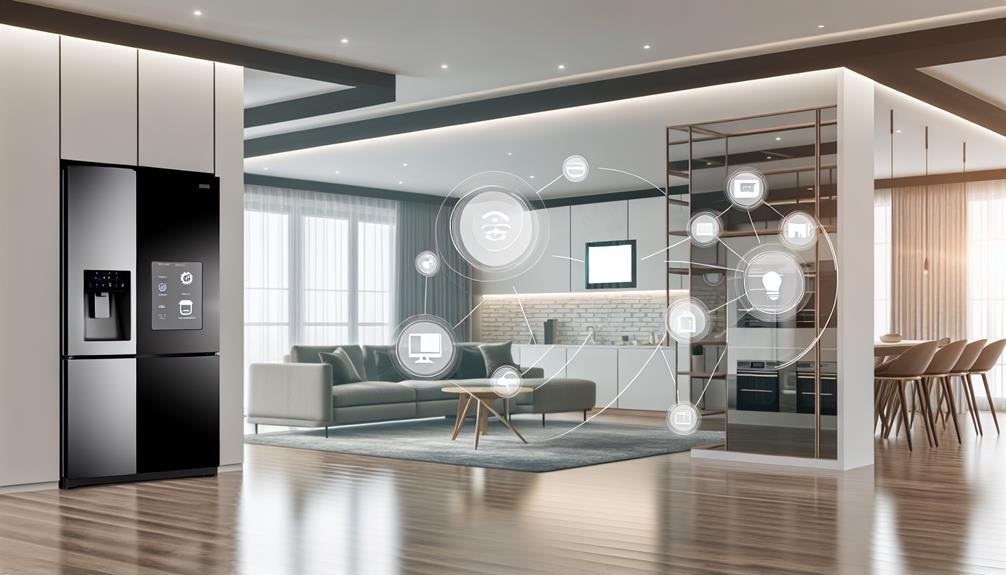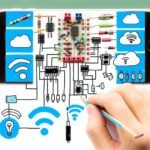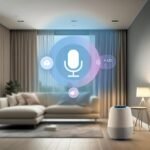Imagine a world where your home is not just a building, but a living, breathing entity that adapts to your needs. This is the realm of smart home automation and the Internet of Things (IoT), where everyday objects are interconnected and communicate with each other.
From controlling your thermostat with a simple voice command to having your refrigerator order groceries on its own, the possibilities are endless.
But as with any technological advancement, there are challenges to overcome. How can we integrate all these devices seamlessly? How can we ensure the security of our interconnected homes?
In this ever-evolving landscape, join us as we explore the benefits, challenges, and future of smart home automation and IoT.
Key Takeaways
- Smart home automation and IoT integration optimize energy usage, resulting in increased efficiency and cost savings.
- Security enhancements in smart home automation provide real-time alerts and proactive measures for home safety.
- The future of smart home automation lies in AI transforming homes into intelligent systems, anticipating needs, and contributing to energy efficiency.
- IoT technology simplifies everyday tasks through seamless connectivity and automation, such as optimizing water usage and automating grocery shopping.
The Benefits of Smart Home Automation
Smart home automation offers a multitude of benefits that enhance convenience, improve energy efficiency, and provide a heightened level of security for homeowners.
One of the key advantages of smart home automation is its ability to optimize energy usage, resulting in increased energy efficiency and cost savings. With the integration of smart thermostats, lighting control systems, and energy monitoring devices, homeowners can easily manage and control their energy consumption. This allows for the adjustment of temperature settings, turning off lights when not in use, and even monitoring energy usage in real-time, all from the convenience of your smartphone or voice-controlled devices.
In addition to energy efficiency, smart home automation also provides unparalleled convenience and comfort. Imagine being able to control your home's temperature, lighting, and even appliances with a simple voice command or through a mobile app. No more getting out of bed to adjust the thermostat or worrying about leaving the lights on when you're not home. With smart home automation, you have the power to create personalized schedules and settings to suit your preferences, ensuring your home is always comfortable and welcoming.
Overcoming Challenges in IoT Integration
To successfully integrate the Internet of Things (IoT) into smart home automation systems, you must address and overcome various challenges. One of the main challenges is the integration of different devices and technologies. With the IoT, there are numerous devices and platforms available, each with its own protocols and standards. This can lead to interoperability issues, making it difficult for devices to communicate and work together seamlessly.
Another challenge is the security of IoT devices. Since these devices are connected to the internet, they can be vulnerable to cyber attacks. To overcome this challenge, homeowners need to ensure that their devices are properly secured and regularly updated with the latest security patches.
Furthermore, there may be compatibility issues between different manufacturers' devices. Some devices may not be compatible with others, limiting the functionality and potential of the smart home automation system.
To address these challenges, it's important to choose devices and platforms that are compatible with each other and have robust security features. Additionally, homeowners should consider using a centralized hub or platform that can integrate and control all the devices in the system. This way, they can ensure interoperability and simplify the management of their smart home automation system.
How Smart Home Automation Enhances Security
Enhancing the security of your home, smart home automation offers a range of features and functionalities that help protect your property and give you peace of mind. With the integration of artificial intelligence (AI) and biometric authentication, smart home security has become more advanced and reliable than ever before.
Artificial intelligence plays a crucial role in smart home security by analyzing patterns and detecting any suspicious activities. AI-powered security systems can learn your daily routines and identify anomalies, such as unexpected movements or access attempts. This allows for real-time alerts and proactive measures to be taken, ensuring the safety of your home.
Moreover, the integration of biometric authentication adds an extra layer of security to smart home automation. Biometric technologies, such as fingerprint or facial recognition, ensure that only authorized individuals can gain access to your home. This eliminates the risk of lost or stolen keys, as well as the need for traditional PIN codes or passwords.
To further illustrate the capabilities of smart home security, consider the following table:
| Feature | Benefits |
|---|---|
| AI-powered surveillance cameras | Real-time alerts and intelligent monitoring |
| Biometric door locks | Enhanced authentication and convenience |
| Smart motion sensors | Immediate detection of unauthorized movements |
| Remote monitoring and control | Peace of mind and control over your home |
| Integration with emergency services | Quick response in case of emergencies |
The Future of Smart Home Automation
With the advancements in technology and the increasing demand for convenience and efficiency, the future of smart home automation holds endless possibilities.
One major aspect that will shape the future of smart homes is the role of artificial intelligence (AI). AI has the potential to transform smart homes into intelligent systems that can learn and adapt to your preferences, making your life even more convenient and personalized.
Imagine a smart home that can anticipate your needs, adjust the temperature, and turn on the lights even before you enter the room. This level of automation is made possible by AI algorithms that analyze data from various sensors and devices within your home.
Another significant impact of smart home automation is its contribution to energy efficiency. By integrating smart devices and sensors, you can monitor and control your energy consumption more effectively.
For instance, smart thermostats can learn your heating and cooling patterns and adjust accordingly, optimizing energy usage. Smart lighting systems can automatically turn off lights in unoccupied rooms, reducing unnecessary energy consumption.
These energy-saving features not only benefit the environment but also save you money on utility bills.
Transforming Everyday Tasks With Iot Technology
The Internet of Things (IoT) technology revolutionizes everyday tasks by seamlessly connecting and automating devices in your home. With IoT, efficiency optimization and simplifying routines become effortless.
Imagine waking up to the smell of freshly brewed coffee, as your smart coffee machine starts brewing based on the alarm you set on your smartphone. As you step into the shower, your bathroom lights automatically turn on and adjust to your preferred brightness. While you get ready for the day, your smart mirror displays the weather forecast and traffic updates, ensuring you leave the house on time.
With IoT, mundane tasks like watering plants become a breeze. Smart sprinkler systems detect weather conditions and soil moisture levels, optimizing water usage and saving you time and money. Forgot to turn off the lights before leaving? No problem. With IoT-enabled lighting systems, you can control your lights remotely using your smartphone, ensuring energy efficiency and peace of mind.
IoT technology also simplifies your grocery shopping routine. Smart refrigerators equipped with cameras and sensors can detect and track the items inside, creating shopping lists and even ordering groceries automatically when supplies run low. This not only saves time but also reduces food waste and ensures you never run out of essentials.






